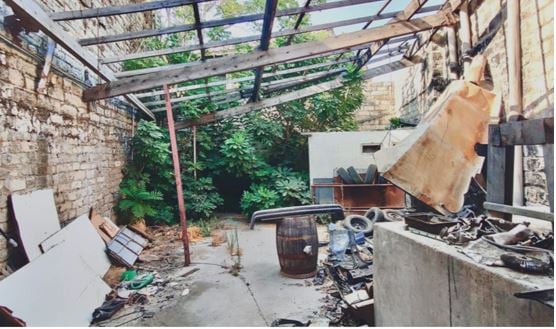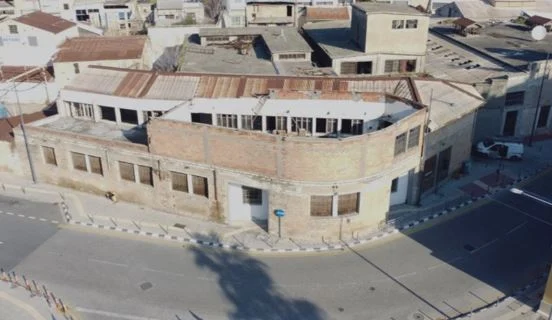In February 2024, a beautiful listed building in the heart of Limassol was destroyed by fire. It was one of the city’s most historic mansions, located on Iphigenia Street and owned by Pavlides. Over the years, the building housed the Cooperative Bank, later the Traffic Police, and eventually became a shelter for some homeless individuals. Three months later, another fire broke out in the abandoned listed building of the old “Apollon” cinema. It is saddening that in a city which has rapidly developed on all levels in recent years, historic buildings are left to the mercy of time, weather, and adverse conditions, with citizens witnessing their destruction.

The dual image of Limassol
Limassol presents two diametrically opposite images. On one side are the luxurious, glossy skyscrapers along the coastal front, constructed in record time over a few years. On the other side is the old town, with its ultra-modern marina surrounded by old, dilapidated buildings awaiting renovation. Investors have expressed interest in the area for some time, but bureaucratic hurdles, mainly from the Department of Town Planning, delay the area’s development plans.
It is understood that certain beautiful buildings fall under the category of listed properties and require due attention to preserve the area’s historical and architectural uniqueness. However, delays benefit neither the residents nor the investors who show interest, nor the tourists, nor even the state, which loses revenue from the area’s overall development. Many investors are interested in creating cultural spaces that would highlight the historical significance of the city’s buildings, uniting the past with the future.

The Limassol area plan
To upgrade Limassol’s centre, the Ministry of Interior and the Department of Town Planning published the “Area Plan” for Limassol’s centre in 2022, a 260-page document outlining all policies and measures.
The areas with the highest investment interest include the Limassol Pottery, the former wineries of LOEL, SODAP, ETKO, and Pantelides, the Lanitis Brothers bottling plant, the KEO facilities, the former Hatzipavlou winery, the Cooperative Carob Mill (including the carob mill and warehouses), and the municipal abattoirs.


Legal and historical protection
For listed buildings, the plan provides legal protection by defining criteria for listing properties and the necessary permits for any work on them. Priority is given to applications for projects involving ancient monuments and listed buildings. Subsidies, tax exemptions, and transferable building coefficients are also offered for maintaining historical buildings.
Work and changes in use for listed buildings must respect the architectural and historical character of the buildings. New additions should be modern, simple, and reversible, avoiding alterations to the original design.

Reasons for delays
Following the recent Local Government Reform, coinciding with municipal elections, responsibility for granting final permits for listed buildings shifted from municipal authorities to the Department of Town Planning in Nicosia. As expected, this change complicated the licensing process, as the department’s workload multiplied.
According to SigmaLive, the main issue with granting final permits and approvals from the Town Planning Directorate in Nicosia lies in the under-staffing of the Conservation Division. This division operates with only three officers per district. Additionally, the Conservation Division inherited old “sins” and delays from the municipalities. Since July, approximately 90 pending cases from Limassol Municipality (some dating back to 2015) were transferred to the department for review. Some cases must be re-examined from scratch, as changes in development plans and the lengthy process may have caused applicants to change their minds.
Despite the heavy workload, the department is working to streamline operations and reduce processing times. It is hoped that new measures will accelerate the process, making permit approvals more accessible for citizens and investors interested in developing Limassol’s historic centre.
Armeftis: A matter of safety and aesthetics
Limassol Mayor Yiannis Armeftis recognises the issue. In a recent Instagram post, he emphasised the need to strengthen the Conservation Division so that pending applications are handled promptly.
Despite the bureaucracy, challenges, and obstacles that can slow progress on various projects, individuals strive to bring positive change despite limitations and increased workloads. These include architects, investors, and progressive, sensitive workers in institutions such as town planning departments, municipal councils, and Limassol Municipality. Hopefully, their efforts will soon yield tangible results, rejuvenating historical areas and breathing new life into Limassol’s abandoned buildings.
What applies to listed buildings
Owners of listed buildings can carry out general maintenance, restoration, modifications, and additions as long as these do not negatively impact the building’s authentic character. There are no restrictions on transferring or selling these buildings, provided the terms of the Conservation Decree are met.
Any intervention requires a Town Planning Permit and special approval (Consent of the Minister of Interior). The consent is issued by the Director of the Department of Town Planning and Housing or the respective municipality, depending on the building’s location. The process involves submitting relevant architectural plans, a description of the work, and photographs.
Changes in use are permitted as long as the new use complies with the Development Plans in force and does not harm the building’s authentic character. The permit process includes drafting plans, obtaining consent and a Town Planning Permit, and, if required, a Building Permit. Financial support requires an application to the Conservation Division of the Department of Town Planning and Housing and approval before starting work.
The work is supervised by the overseeing designer, responsible for completing the project and updating the authorities on progress and completion.
The importance of developing listed properties
Listed buildings are integral to a city’s history and identity, representing architectural heritage and the cultural values of past eras. Their maintenance ensures this heritage is preserved for future generations, enabling people to understand their locality’s history and development. When residents can recognise the features of their old neighbourhoods, they feel connected to their history and traditions. Moreover, upgrading and reusing listed buildings can create vibrant neighbourhoods where history and modern life coexist.
Restoration and integration of listed buildings into urban development can enhance a city’s aesthetic value, adding uniqueness to the urban fabric. In areas of historical or cultural significance, listed buildings are major attractions for tourists, boosting tourism and the local economy. Restoring and repurposing listed buildings can provide significant economic opportunities, such as creating commercial spaces, offices, or residences, boosting the property market and creating jobs in construction and maintenance. Additionally, listed buildings can host cultural and social events, enhancing public life and community spirit.
The abandoned Karnagio
Another significant issue for the city is the Karnagio area between the two ports, which is marked by decline. The Limassol Chamber of Commerce and Industry (EBEL) has long emphasised that this neglected area could become an economic hub. Since 2015, discussions on its regeneration have included a plan with high-rise buildings, green spaces, pedestrian paths, and cycle lanes. However, the area lacks infrastructure connecting it to the city centre, and no political decision has advanced the project. The Ministry of Interior noted that development delays stem from the need to relocate shipbuilding businesses requiring immediate sea access. The ministry claims a new initiative is underway to identify suitable spaces and incentives for relocating these businesses. Although it was stated that the permit regulation process has progressed, faster progress is still expected from the Regional Organisation.
Also read: Registrations for the 2025 Limassol Carnival open next week


